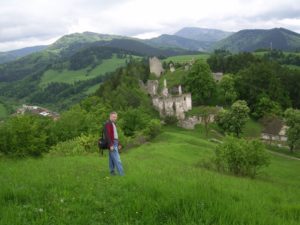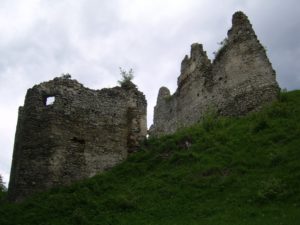Szklabinya

Szklabinya or Szklabinyaváralja (Sklabiňa) can be found in Slovakia but it used to be the part of the historical Upper lands/Horná zem/Felföld region of the Kingdom of Hungary (Uhorsko) until 1918 Hungary.

Allegedly, there had been a prehistoric fort on the site of the present castle. The castle was first mentioned in a document as a “villa” in 1242 and the Hungarian king gave it to the Zólyomi Clan, the greatest noble family of the area at the end of the 13th century or a little bit later. The castle appeared in a document as “Sklabonya” in 1258. The Zólyomi Clan was the ancestor of the famous Balassa family, and it is thought that they were the ones who had the first wooden fortification built in the 13th century. Then, it was Master Doncs, the son of Zólyomi Csorba Domokos who built a proper stone castle between 1304 and 1309. It consisted of a citadel, an inner castle, and a lower castle.

We know that Master Doncs had to swear fealty in 1306 to Lord Csák Máté, the mighty oligarch whose domains covered almost the whole Upper Lands of Hungary. It was how Szklabinya castle became one of his forts. Lord Csák Máté was able to increase his power by relying on the swords of the noblemen whom he has conquered. He used their soldiers to take more lands by force. There is a document signed by Master Doncs from 1309 that was issued in Szklabinya. In it, Master Doncs indicated himself as the follower of Lord Csák Máté. The rule of this oligarch ended only in 1321 when he died but Szklabinya castle became the center of the county in 1320. Soon, the troops of King Anjou Károly Róbert took over his lands.

As for Szklabinya, it was Master Dancs who occupied it but the king did not grant him the right to own it as before. He was acting only on behalf of the monarch until his death. Then, the castle became the headquarters of the Chief Comes of Turóc County because it was in a better location than Turóc (Znió) castle. King Zsigmond of Luxemburg had the castle’s walls enlarged, the walls were built 2 meters wide. However, he needed cash for his wars against the Turks so he pledged the entire Turóc County in 1410 to the Polish Baliczky family. The Baliczky family received the rank of the comes of the county as well, and they additionally got Újvár castle from Sáros County. Altogether, they paid 13,000 gold Forints for this. This way, they could collect the income in the region until 1470. Also, there was a major rebuilding of the castle in the 1460s.
When the domains returned to King Matthias Corvinus, he had the castle enlarged. Soon, the king gave Turóc County to his Jewish Treasurer, Ernuszt János (who had to convert to the Roman Catholic faith). He was appointed as hereditary Comes of Turóc County which was a high mark of appreciation. We know that King Matthias was hunting near Szklabinya castle in 1471, more precisely he was at Királylese. (Please, note that I use the Oriental name order for Hungarians where family names come first.)

Later, Matthias realized that he would not have a male heir from his Queen Beatrix and wanted to concentrate more power on his natural son’s hand, Corvin János, prince of Liptó. He gifted Szklabinya castle and its villages to Corvin János in 1482, trying to make him the greatest landlord of the country. Indeed, his natural son was the wealthiest lord of Hungary in 1490 when Matthias died, he owned 30 castles, 17 fortified palaces, 47 market towns, and about 1,000 villages.

Unfortunately, Corvin János was not crowned after the death of his father. The most loyal noblemen of Matthias were the ones who hurried to deprive Corvin János and take away his domains. One of them was Palatine Szapolyai István who died before 1499. He managed to gain lots of lands in favor of his son, János (later king of Hungary). Palatine Szapolyai took Szklabinya castle away from Corvin János in 1494. In 1495, the castle suffered a great fire.

We know that King Lajos II of Hungary lost his life in the Battle of Mohács in 1526. The new king became Szapolyai János but Habsburg Ferdinand also claimed the throne. The bloody Dual Kingship of Hungary commenced, and the troops of Ferdinand succeeded in taking the Upper Lands of Hungary in 1527-28. It was the time when Ferdinand took hold of Szklabinya castle and gave it to Révay Ferenc.

in 1540, Lord Révay also received the Blatnica castle which was nearby. During the next decades, many members of the Révay family were appointed as Chief Comes of Turóc County. Fortunately, Turóc was a quite peaceful region during the Ottoman wars in the 16th century, but it had to be reinforced in the 17th century against the intensifying Turk attacks. The Révay family had owned it until the 20th century. They had turned it into a Renaissance palace, and it had been reinforced several times between 1550 and 1605.
During the anti-Habsburg war of Prince Bocskai István, the castle fell to the Hajdú soldiers of Bocskai in 1605. By then, the Révay family had already fled to the west, taking shelter in their safer domains. The Hajdú soldiers plundered the castle and burned it. According to the Treaty of Vienna that settled the Bocskai uprising, Szklabinya castle and most of the Upper Lands were reunited with the Kingdom of Hungary.
The Révay family returned but they did not rebuild the ruined castle in 1610. Instead of this, they built a reinforced Renaissance palace on the foot of the hill, which was more comfortable. However, it was still connected to the old castle. Many stones from certain sections of the old walls were used for the construction of the new fortification.

Despite the towers and the walls, the new palace did not have military significance, it was good only against smaller raiding parties. Accordingly, it opened its gates before the troops of Prince Bethlen Gábor of Transylvania in 1619. Then, Baron Révay Péter, Chief Comes of Turóc County was not there: he was also the Guardian of the Hungarian Crown so he had to travel with it. Later, Szklabinya castle was taken by Prince Rákóczi György of Transylvania in 1644.

During the War of Independence of Rákóczi Ferenc II, the rebel “kuruc” troops, led by Count Bercsényi Miklós and Baron Károlyi Sándor defeated the Imperials in the battle of Zólyom in November 1703. Their soldiers occupied the region and we know that Szklabinya castle was theirs in 1704. They took Chief Comes Révay Ferenc to the Castle of Eger where he died in 1707. There were no more fights in Szklabinya castle during the war of Rákóczi. All we know is that the army of Rákóczi, led by the prince suffered a major defeat in August 1708 at Trencsén castle, and the “kuruc” rebels were driven out from the region.

As the Révay family had always been loyal to the Habsburgs, they got all their properties back, and their fortified palace could avoid the destruction, too. Although the family moved to the more comfortable palace of Mosóc in the early 1800s, the fortified building at Szklabinya was not neglected, it had an economic function. The tragic destruction took place in WWII when the Renaissance castle burned down during the fight between the Germans and the partisans.
It has never been restored since then. However, according to information from 1998, one of the gate towers was restored by local young people. A small museum also opened its gate in a building in front of the castle, and further construction is going on. The area of the upper castle was well-maintained in 2018 but the renovation of the walls would be quite timely.

Not so long time ago it was for sale along with a 9600 square-meter area, in the Zsolna district. Its price was 250,000 EURO (about 77,5 million HUF) under the terms that the buyer would have to spend on the reconstruction, too. I have heard that further renovations are being carried out in our days but there is no information about the above-mentioned business.
I can recommend the community of Szklabinya which is doing a fine job of preserving the history of the place:
https://www.facebook.com/sklabinahrad

Dear Readers, I can only make this content available through small donations or by selling my books or T-shirts:
Please, feel free to support me with a coffee here:
You can check out my books "33 Castles, Battles, Legends" and "The Ring of Kékkő Castle" on Amazon or Draft2Digital, they are available in hardcover, paperback, or ebook: https://www.amazon.com/dp/198020490X or at https://books2read.com/b/boYd81
 My work can also be followed and supported on Patreon: Become a Patron!http://Become a Patron!
My work can also be followed and supported on Patreon: Become a Patron!http://Become a Patron!


https://hungarianottomanwars.myspreadshop.com/all


































